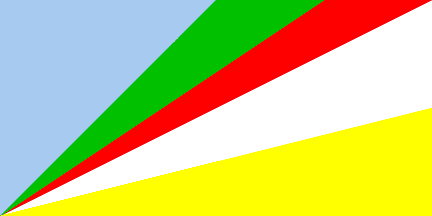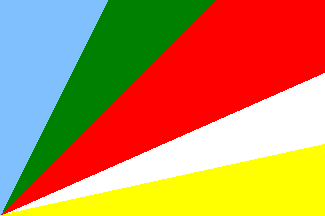
This page is part of © FOTW Flags Of The World website
Prado (Tolima, Colombia)
Last modified: 2004-02-14 by dov gutterman
Keywords: tolima | colombia | prado |
Links: FOTW homepage |
search |
disclaimer and copyright |
write us |
mirrors

by Carlos Thompson, 28 December 2003
See also:
Overview

by Jairo Alonso Méndez Méndez, 23 December 2003
Here the flag for the municipality of Prado (Tolima), as
designed by me (it takes as a guide the design of the flag of the
Seychelles - see: Original
Proposal) and as shown on the webpage of the municipality
<www.gratisweb.com>:
"A sky Blue band in a 45 degree angle from the left lower
vertex, meaning the hydrological potential represented by the
Magdalena River, or Fatherland river, due to its influence on
indigineous culture, by serving as transportation artery during
the conquering and colonial periods, during the emancipating
jousts of our Country and of South America, in the comertial,
industrial, navigational and aviation development of Colombia;
the Negro (Black) and Cunday Rivers, main tributaries of the dam
that originates the Prado river. [This means that there is a sky
blue sector, (from the hoist) to a line 45 degrees from the lower
hoist corner of the flag. This represents the
hydrographical resources of the municipality: the Magdalena River
(Colombia's main river), the Prado River and its dam, and the
Negro and Cunday Rivers, tributaries to the Prado reservoir.]
From the same vertex and below the Bue, another band, Green,
whose meaning is the fertilization of the lands of Prado and
Purificación municipalities from the irrigation district that
originates from the Prado River dam, and which have incorporated
to the national economy the fruits production which have demand
in the international market. It also means the green
landscapes of the cordillera that frame the municipality which
bring the tourist rest to his spirit. [This means, that from the
same lower hoist corner there is a green sector, bellow the 45
degree line. This represents the green landscape of the
corrdillera and the agricultural potential of the Prado reservoir
irrigation district.]
From the same vertex and bellow the former, there is a band of
color red, meaning the live the Poincosque natives offered when
razed by the sword of conquistador Gonzalo Jimenez de Quezada,
and in memory of the martyrs sacrified in the main square,
sacrified by the most sublime love of the freedom of the
Americas, they were martyr Julian Valdes, from a famous family of
Prado; the heroine Luisa Trilleros, as well as the martyrs
Domingo Ducuara, Pantaleon Murcia and Juan Jose Tamara from the
municipality of Natagaima; Jose Tellado from the monicipality of
San Luis, and Ramon Antonio Vernaza from Espinal. [This means
that there is a red sector bellow the green one, which represents
the Natives that lived there before the spaniards, and the
martyrs that were executed in Prado municipality's Main Square
during the independece period.]
Originated from the same vertex bellow the Red, there is a band
of White color, symbol of peace that must construct prosperity,
longing and realizations of all inhabitants of the municipality,
as fundamental elements of their push.[White means peace and the
values of the people of Prado.]
From the same vertex and bellow white a yellow band originates,
whose meaning is the energetical potential of the Tolima
department, originated in Prado and broadcasetd through the
national territory by the electrical interconection system.
The construction of this emblem is based in a rectangular
geometrical shape, length equal to twice the width. The
limits of the bands will be: from the lower left vertex to half
the length of the upper line, to half the distance from this to
the upper right vertex; the upper right vertex; and half the
right side. These bands make triangeles that oppen to the
upper part of the emblem, meaning the constance of historical
development of our generations.
Jairo Alonso Méndez Méndez (translation and remarks by
Carlos Thompson), 23 December 2003
Original Proposal

by Jairo Alonso Méndez Méndez, 23 December 2003
Construction Sheet

by Carlos Thompson, 28 December 2003